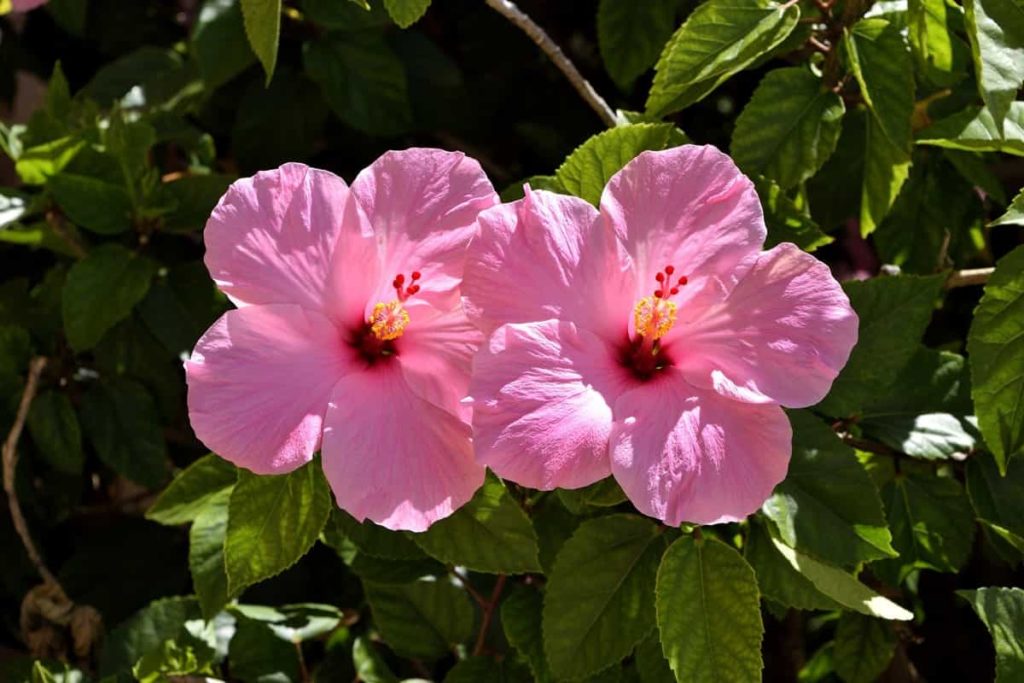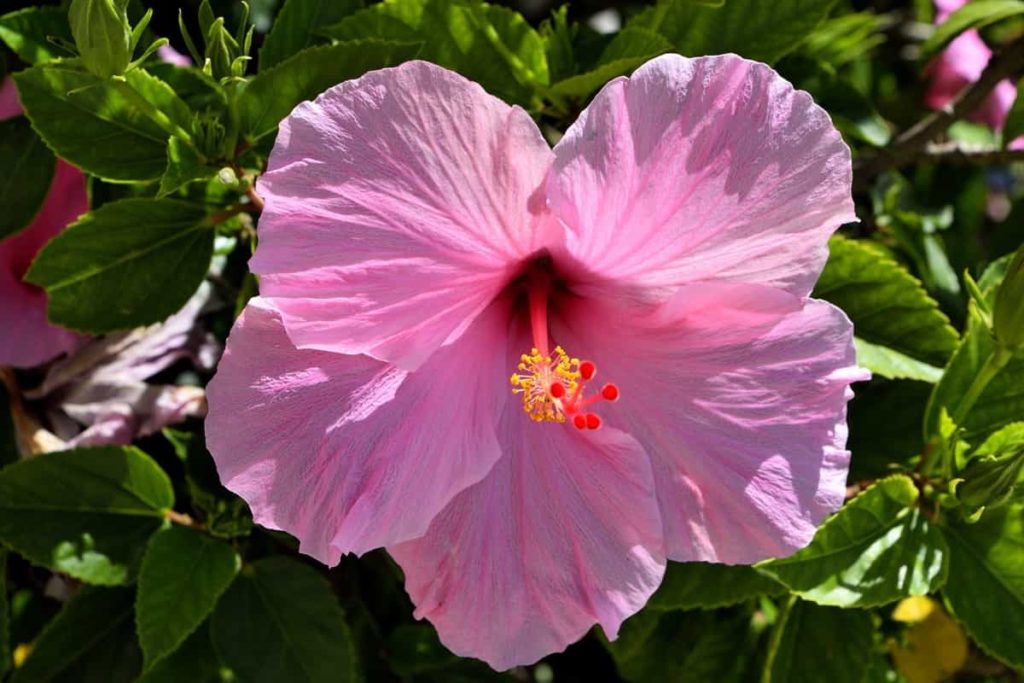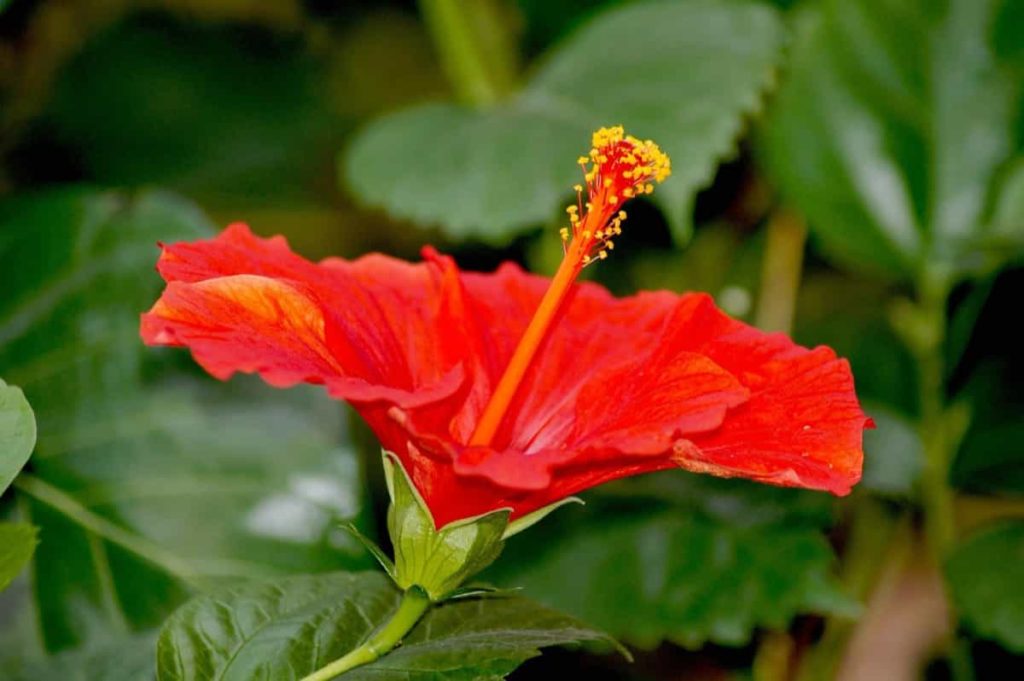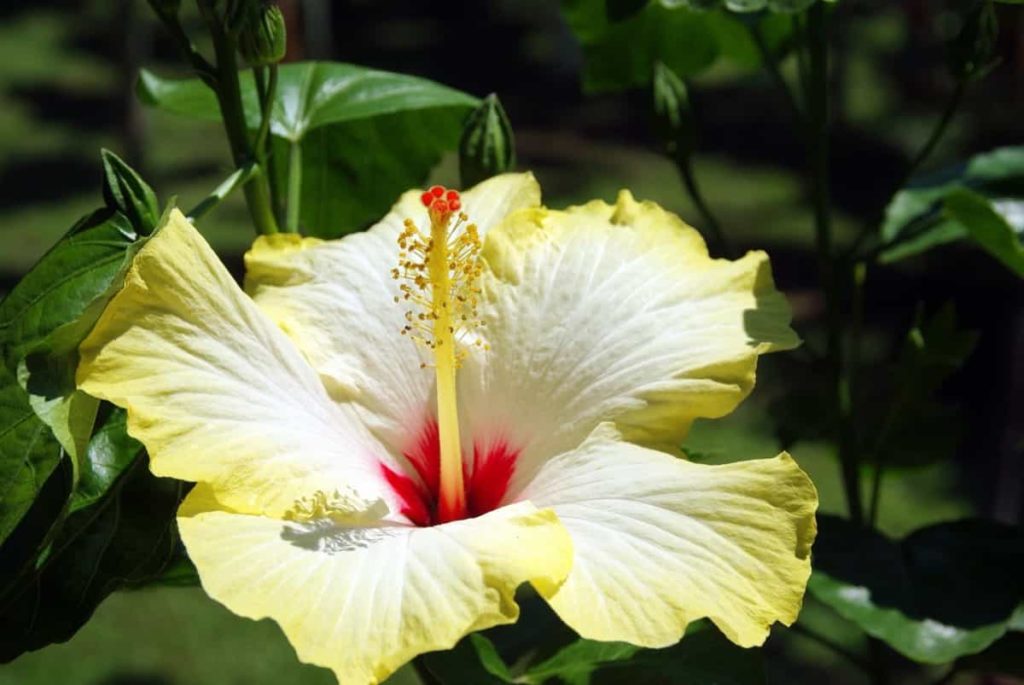Hibiscus are tropical plants that thrive in full sunshine, moist soil, with constant warm temperatures. More moisture and away from wind and drought. Hibiscus plants add beauty to your garden. They bloom beautiful flowers that give the visitor a charming look. The Hibiscus plant requires special care. Hibiscus can suffer from various pests and conditions in the landscape, with a little more control than others.

Often, improper drainage and air circulation create an atmosphere of attacking Hibiscus plants for various pests and diseases. Hibiscus needs well-draining soil and good air circulation for proper growth. Hibiscus plants are very sensitive to certain pesticides, so gardeners should read labels before applying.
15 common Hibiscus plant problems
Hibiscus leaves turn yellow
Insufficient light
Hibiscus leaves may be yellow if they are not getting enough light. Too much direct sunlight causes small white spots to appear on the leaves. However, very little light will not allow the plant to produce enough chlorophyll to keep the leaves green.
Temperature changes
Extreme heat and cold can cause your Hibiscus leaves, to turn yellow as there may be extreme changes in humidity levels.
Deficiency of nutrients
A deficiency of nutrients can cause yellow leaves on your Hibiscus. Nutrient-deficient Hibiscus plants can produce iron chlorosis, causing leaves to turn yellow with green veins.
Too little or too much water
Tropical Hibiscus plants usually require a lot of water, but too much or too little water can cause yellow leaves. More water can also cause root rot.
Climate change
Hibiscus plant leaves are sensitive to changes in the surrounding environment. You might expect the leaves to turn yellow if you recently moved a potted Hibiscus or transplanted it to a new garden area.
In case you missed it: How to Prepare the Soil for Hibiscus Plants: Best Soil Mix, pH, Compost, and Recipe

Pest attack
Hibiscus is attacked by spider mites, aphids, and mealy bugs. Damage caused by insects can cause the leaves to turn yellow. Check the bottom of the leaves for the marks left behind by the mites.
Solution
Hibiscus plants need full sunlight but should be protected from direct sunlight during the hottest part of the day. If the leaves are turning yellow, move the plant where it can shade in the afternoon. Maintain uniformly moist soil. A single layer of mulch at the base of the outer plant can help maintain soil moisture.
Make sure potted plants are in well-drained soil. If your Hibiscus is planted in a potting mix that is too alkaline or too acidic, it can prevent the use of nutrients. The ideal soil pH level for Hibiscus plants is between six and seven. Planting specially prepared fertilizer on Hibiscus plants is the best way to ensure that the plant gets enough nitrogen, phosphorus, and potassium. You can also modify the soil with a small amount of Epsom salt, increasing the plant’s ability to absorb nutrients.
Protect your Hibiscus from harsh conditions. Increase the water during the heatwave to ensure that your plant has enough water. If you live in a low climate, move your potted Hibiscus indoors during the cold winter month. Protect your Hibiscus from pests. If you suspect your plant has been affected by pests, sprinkle soap water, insecticidal soap, neem oil, or organic pesticide on the entire plant.
Hibiscus leaves curling
The biggest reasons why Hibiscus leaves curl are underwater, poor soil, poor drainage, nutrient deficiency, cold weather, or high water.
Not enough water
Hibiscus is a tropical plant and thrives on regular water to grow well. Plants that dry up in winter or an unusually dry summer will be affected, and their leaves may start to curl.
Solution – Hibiscus leaves turn yellow or brown and die due to dehydration, so it is time to work fast. If the soil is dry water deeply 2 inches below. Keep the plant well-watered until next week and see if the leaves are straight. If they get damaged, they may fall, but this will save the remaining plant, which will grow new leaves after getting enough water.
Poor quality soil
The Hibiscus plant likes to drain well, nutritious soil, so those planted in pots will need good quality potting soil. The Hibiscus plant, which has been in the same pot for 2 to 3 years, may suffer from compacted or less nutrient soil.
In case you missed it: Growth Stages of Flowering Plants: Rose, Marigold, Hibiscus, Dahlia, Gerbera Daisy, and Jasmine

Solution – If you suspect a problem causing leaf curl, repot your Hibiscus may be a good idea. The potting soil will compact over time so check to see if the soil absorbs the water well. If the water goes straight out from the bottom or sits on top, it may be time to repot your plant.
Not enough drainage or nutrients
The Hibiscus plant needs regular supplies of nutrients, especially in the hot months when they are flowering and producing flowers.
Solution – A fertilizer that is made specifically for Hibiscus, which is low, is the phosphorus idea. Look for one that includes minerals, including iron, essential for the blooming and growing of Hibiscus plants.
Cold weather
Hibiscus loves hot tropical weather, and if they experience frost, it can damage leaves and cause them to be curled. Leaves in very cold weather or frost drop off completely, but you can avoid them if you catch them quickly.
Solution – Move the potted Hibiscus to an area that is sheltered. For Hibiscus in the ground, if you know that the frost is coming, you can drap a light shade cloth over the plant.
More water or lots of rain
Too much water can also harm Hibiscus plants, making them experience leaf curl. Too much water in the soil can starve oxygen roots and make it more difficult for the plant to absorb nutrients.
Solution – Make sure they are not sitting in a water tray for indoor Hibiscus. After watering, let the water drain before placing it back on the tray or empty it after removing it for 30 minutes or more. For outdoor Hibiscus plants, a single layer of bark mulch can help disperse some rain and absorb extra moisture while keeping it away from plant roots. Because the Hibiscus plants with high water in the pots move them into bright sunlight. While the direct hot sun can cause damage, bright light can help the soil out and help the plant recover.
Insect pests
Insects attacking Hibiscus plants can have another reason for leaf curl, so check the leaves and up and down to see if you can see any insects.
Aphids are common pests that can attack the leaves and trunks of the Hibiscus. These small, green juice-sucking insects can attack Hibiscus, especially in the fall and spring. They will suck the juice from the stem and release a sticky honeydew that can attract ants.
Solution – To prevent the aphid attack on the Hibiscus, start with a high-powered hose and wash off the extra insects. You can sprinkle a thin mixture of dish soap and a few drops of water on the affected area. If it doesn’t work, try some neem oil, which you can spray on the aphids.
Hibiscus plant leaves drooping
The main reasons for a droopy Hibiscus plant are lack of sunlight, water, and nutrients. Pest attack can also lead to a droopy Hibiscus plant. Provide plenty of light, water, and nutrition to your Hibiscus plant. Also, take immediate action if you notice pests or diseases.
Poor water habits
Both more water and underwater will result in limp leaves. The leaves will lose their rigidity if you don’t give them enough water. The roots suffocate when they get too much water. That is why they will bow down due to lack of moisture.
Solution – Soak the soil well if you have not watered your plant for a long time. Water should reach its roots. To confirm this, water your pot plants until the excess water is drained. For ground plants, build a shallow well around the plant base to ensure that water reaches the root of 6 inches. The plant is ready to take water when 1-2 inches dry on top.
Lack of sunlight
Due to lack of sunlight, the leaves will become droopy. Another sign of low light is yellow leaves.
In case you missed it: Best Fertilizer for Hibiscus: Homemade, Organic, Liquid, NPK, and Compost Manure

Solution – You need to move your plant to a sunny spot. It will be easy for the pot plant. But for ground plants, you may have to transplant them. During cloudy days, fix artificial lights for Hibiscus beds.
Excessive heat
Hibiscus needs a lot of sunlight to thrive, but you should be careful when the climate is too hot. High temperatures and heat can increase the risk of sunburn and overheating, thus producing droopy leaves. In addition to droopy leaves, it can cause bud drops and other problems.
Solution – Make sure the temperature is between 13 to 23°C. Hot temperatures are common in summer, especially in hot tropical areas. If you use a terracotta container, place it in another container. Keep the water Hibiscus and soil under control daily in summer. Sometimes the plant may need to be watered twice a day.
Nutrient deficiency
Hibiscus plants are heavy feeders and need a lot of nutrients to stay healthy. The deficiency of nutrients like potassium, zinc, magnesium, iron, etc., will cause bent leaves. Minor nutrients for Hibiscus plants are equally important as the three major nutrients. Giving proper fertilizer to the plant will enrich the soil with large and minor nutrients and fix the droopiness.
Solution – Never skip fertilizing in spring and summer. It increases their growth and keeps the plant fresh and full of straight leaves. For liquid fertilizer, use it every two weeks in the growing season if your plant lacks micronutrients like zinc, magnesium, or iron. Add a few inches of compost as a mulch to improve soil fertility.
Transplant shock
Hibiscus plants are a little sensitive to sudden changes.
Solution – When you grow Hibiscus from seeds, most people start indoors and transplant them outside when they become seedlings. Before you move, you should let the seedlings harden. The plant faces a change from one container to another, turning to new soil. This change will put stress on the plant and result in limp leaves. Leaves sometimes turn yellow or brown and fall. Once it adjusts itself to a new environment, the leaves will become normal.
Pests
Aphids, spider mites, scales, mealybugs, and white flies are responsible for droopy leaves. These juice-sucking pests suck the juices. Due to the lack of these juices, the leaves lose fresh and straight staying energy and become droopy.
Solution – Sprinkle neem oil on the affected area. Apply neem oil when the sun sets; otherwise, direct sunlight can burn sprayed leaves. Use insecticidal soap and coat the pests to stop their oxygen and kill them.
Diseases
You can identify fungal disease when you see all the green leaves have suddenly wilted and limp.
Solution – Avoid spraying leaves while watering. Remove the affected colorless parts as soon as possible. Try to shade the plant for a few days until recovery. Do not fertilize in dry soil. Always moisten the soil before feeding.
Dying Hibiscus plants
Proper water
Water stress is one of the most easily avoidable causes of hibiscus plant death. Too little water leads to hungry plants; too much water causes diminished health, while excessive water leads to drowning and the death of plants.
Solution – Water with direct water methods only during drought or high temperatures.
Canker disease
Canker disease on the Hibiscus trees can lead to plant death. Canker disease spreads freely from sources like wind and rain, attacking natural blooms or trees through wounds.
Solution – Fungicides will not control canker disease; you will remove and destroy parts of infected plants. In addition, it is important to avoid accidental injuries on the tree and maintain sterile devices to prevent disease.
Root rot
Root rot affects the Hibiscus trees and can lead to immediate death.
Solution – Excellent soil drainage is essential, as water-logged conditions encourage the development of diseases.
In case you missed it: Hibiscus Gardening For Beginners – How To Start, FAQs

Hibiscus flowers are falling from the plant
Hibiscus flower and bud drop can also result from several other factors such as nutritional deficiency and environmental conditions.
Solution – Bud drop on Hibiscus flowers is often associated with a basic problem you can easily correct. For example, inadequate water, excessive temperature changes, and overfertilizing can all trigger the blooming of Hibiscus trees. Hibiscus flowers require a lot of light, more moisture, and moist soil. They also need to be fed regularly with fertilizer as per the instructions. The best way to keep Hibiscus flowers healthy is to meet their needs and often check plants for symptoms of problems.
Pests
Thrips
These pests are responsible for the bud drop in the Hibiscus. They get inside the buds, damaging these buds before they get a chance to bloom.
Solution – When the bud reaches the soil, the larvae burrow into the earth. So, you have to remove all affected buds before they fall. Use a systematic one if you treat the thrips with pesticides. Sprays will not enter the larvae inside the buds.
Scales
Scales on Hibiscus look like small black or brown raised dots. Scale is another pest that sucks juice from plants, and large infections can cause severe damage.
Solution – Systemic pesticides should control the scale. You can eliminate small infections with your fingernail.
Mealybugs
Mealybugs are white, soft-bodied pests that are sometimes inside the cottony mass. They eat plant juices, which can cause prevent flowers from blooming. The mealybugs are tropical and can appear on your Hibiscus after being brought indoors for winter.
Solution – Small infections can be managed by dubbing cotton swabs immersed in rubbing alcohol. You can use pesticide soap or a systemic pesticide. Or consider predatory insects.
Spider mites
Spider mites will feed your plant, and the leaves will look mottled. The good news is that spider mites will not usually kill a plant and are easy to treat.
Solution – You can remove them from your Hibiscus by giving them a soft blast with the hose. You can also use chemical treatment in severe cases.
Aphids
They eat the plant leaves, giving them a mottled look like spider mites. If you have aphids in Hibiscus, its leaves will not grow well. And they will look yellow and unhealthy.
Solution – A natural way to treat the aphids is to introduce predatory insects like ladybugs and lacewings. They will eat the aphids but retain the rest of your plant. You can also spray your Hibiscus with a hose to remove the aphids or use pesticides.
Diseases
Black spot
Symptoms are black spots on the upper surface of leaves, which are unattractive but do not damage the plant. The fungus grows in cold, moist weather.
Solution – Fertilizer can help your Hibiscus grow fresh new leaves, but no treatment can remove black spots. Cleaning the fallen infected leaves can help prevent the disease from spreading. Badly affected leaves can be removed from the plant and destroyed.
Bacterial leaf spot
The bacterial leaf spot develops in the wet and rainy season and is spread by spraying water. If severe, leaves may fall, but the disease does not cause severe damage.
Solution – Like black spots, a good cleaning is important with the place of the bacterial leaf. Removing leaf debris from under the plant, cutting badly affected branches, and watering from below will help keep the disease under control.
Rust
Rust caused yellow or orange raised dots (pistols) under the leaves and rusted spots on top. It can leave rust marks on your fingers when you touch it. It develops when the leaves have been very wet for a very long time.
Solution – Rake up all fallen leaves, and trim and destroy badly affected branches. Improve air circulation, and do not water from above. You can spray the first affected plants with horticultural oil before the leaves emerge at the beginning of the growing season. It works to prevent new diseases.
In case you missed it: Growing Hibiscus Plants in Pots from Cuttings, Seeds

Botrytis blight
This fungal disease is formed on buds, flowers, and leaves. High humidity and low airflow create an environment for the development of Botrytis. Flowers are colorless and spotted; flower buds rot and fall before they open.
Solution – Prune and destroy all affected flowers and leaves. Do not give water from the top; try to keep the leaves dry. If Botrytis is a persistent problem, you can use a fungicide as a preventive.
Powdery mildew
Powdery mildew causes a white coating on leaves and trunks. It develops when the days are hot and nights are cold at the end of summer and early autumn. Often powdery mildew does not damage the plant; it is just ugly.
Solution – Fungicides need to be applied before the symptoms appear to control powdery mildew.
Conclusion
Hibiscus plants love hot, tropical weather and will thrive when given enough water and planted in good soil. Hibiscus will reward you with beautiful flowers and bright green leaves when they are taken care of. You know the reasons behind unhealthy Hibiscus plants so that you can solve these problems and preserve your plant. This article will help you grow your plant healthy, bloom more flowers, and enhance your garden shape.
- Flower Garden Designs and Layouts for Beginners
- Planting and Spacing Techniques in Papaya: A Beginner’s Guide
- Growing Gold: Essential Techniques for Planting Pineapples
- How to Make Kalanchoe Plant Bushy: Home Remedies and Solutions
- 11 Reasons Why Your Gardenia is Not Blooming: Home Remedies and Solutions
- Eco Elegance: The Guide to Designing a Drought-Tolerant Landscape
- Gardening on a Slope: Strategies for Hillside Landscaping
- Nourish and Flourish: Top Organic Mulches for Thriving House Plants
- Everything You Want to Know about Indian Mogra Flower: Discover Uses and Growing
- Green Thumb Success: Expert Tips for Cultivating Greenhouse Pumpkins All Year Round
- Maximize Growth & Flavor: The Ultimate Guide to Companion Planting in Herb Gardens
- How to Control Rhododendron Problems Naturally: Home Remedies and Organic Ways to Fix Them
- Natural Magic: The Remarkable Benefits of Cinnamon for Plants
- Best Steps to Revive Dying Tulip with Natural and Organic Treatment
- 10 Reasons Why Your Angel Trumpet is Not Blooming: Remedies and Treatment
- How to Fix Periwinkle Leaf and Flower-Related Problems: Natural Remedies and Solutions
- How to Fix Zinnias Leaf and Flower Problems: Discover Natural and Home Remedies
- Organic Steps to Induce Lemon Tree Flowers: A Comprehensive Guide
- Bloom Booster: Crafting the Perfect Homemade Bougainvillea Fertilizer
- Optimizing Growth: A Guide to Applying NPK Fertilizer for Potted Plants
- 10 Best Homemade Fertilizers for Rubber Plant: DIY Recipes and Application Method
- How to Boost Female Pumpkin Flowers: Effective Steps for More Flowers and High Yields
- Transform Your Indoor Garden: Top Benefits of Pink Salt for Houseplants
- 10 Best Homemade Fertilizers for Peacock Plants (Calathea): Easy DIY Guide
- Unlock Blooms: 9 Reasons Why Your Potted Chrysanthemum is Not Blooming
- 8 Reasons Why Your Potted Hibiscus is Not Blooming: Fix it with Simple Solutions
- Unlock Blooms: 9 Key Reasons Your Potted Frangipani Won’t Flower
- 10 Reasons Why Is My Ice Plant Not Blooming: Remedies and Treatment
- 10 Reasons Why My Potted Hydrangea Not Blooming: Treatment and Remedies
- 10 Reasons Why is My Wisteria Not Blooming: Remedies and Treatment
- 10 Reasons Why is My Goldfish Plant Not Blooming: Remedies and Treatment
- Maximize Your Space: Ultimate Guide to Balcony Gardening with Grow Bags
- 10 Reasons Why Your Iris is Not Blooming: Remedies and Treatment
- 10 Reasons Why Your Anthurium Plant is Not Blooming: Treatment and Remedies
- 10 Reasons Why Your Aquaponic Plants Are Not Flowering: Remedies and Treatment
- 10 Reasons Why Your Agapanthus is Not Flowering: Remedies and Treatment